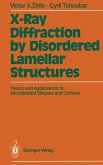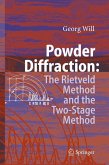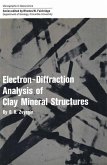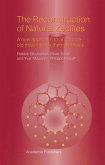Victor A. Drits
Electron Diffraction and High-Resolution Electron Microscopy of Mineral Structures
Übersetzung: Smoliar, Bella B.
Victor A. Drits
Electron Diffraction and High-Resolution Electron Microscopy of Mineral Structures
Übersetzung: Smoliar, Bella B.
- Broschiertes Buch
- Merkliste
- Auf die Merkliste
- Bewerten Bewerten
- Teilen
- Produkt teilen
- Produkterinnerung
- Produkterinnerung
The decision of Springer-Verlag to publish this book in English came as a pleasant surprise. The fact is that I started writing the first version of the book back in 1978. I wished to attract attention to potentialities inherent in selected-area electron diffraction (SAED) which, for various reasons, were not being put to use. By that time, I had at my disposal certain structural data on natural and synthetic minerals obtained using SAED and high-resolution electron microscopy (HREM), and this stimulated my writing this book. There were several aspects concerning these data that I wished to…mehr
Andere Kunden interessierten sich auch für
![X-Ray Diffraction by Disordered Lamellar Structures X-Ray Diffraction by Disordered Lamellar Structures]() Victor A. DritsX-Ray Diffraction by Disordered Lamellar Structures77,99 €
Victor A. DritsX-Ray Diffraction by Disordered Lamellar Structures77,99 €![Powder Diffraction Powder Diffraction]() Georg WillPowder Diffraction74,99 €
Georg WillPowder Diffraction74,99 €![Electron-Diffraction Analysis of Clay Mineral Structures Electron-Diffraction Analysis of Clay Mineral Structures]() B. B. ZvyaginElectron-Diffraction Analysis of Clay Mineral Structures77,99 €
B. B. ZvyaginElectron-Diffraction Analysis of Clay Mineral Structures77,99 €![Structural Mineralogy Structural Mineralogy]() J. Lima-de-FariaStructural Mineralogy147,99 €
J. Lima-de-FariaStructural Mineralogy147,99 €![Structural Mineralogy Structural Mineralogy]() J. Lima-de-FariaStructural Mineralogy154,99 €
J. Lima-de-FariaStructural Mineralogy154,99 €![Feldspars and their Reactions Feldspars and their Reactions]() Ian Parsons (Hrsg.)Feldspars and their Reactions233,99 €
Ian Parsons (Hrsg.)Feldspars and their Reactions233,99 €![The Reconstruction of Natural Zeolites The Reconstruction of Natural Zeolites]() Habbib GhobarkarThe Reconstruction of Natural Zeolites84,99 €
Habbib GhobarkarThe Reconstruction of Natural Zeolites84,99 €-
-
-
The decision of Springer-Verlag to publish this book in English came as a pleasant surprise. The fact is that I started writing the first version of the book back in 1978. I wished to attract attention to potentialities inherent in selected-area electron diffraction (SAED) which, for various reasons, were not being put to use. By that time, I had at my disposal certain structural data on natural and synthetic minerals obtained using SAED and high-resolution electron microscopy (HREM), and this stimulated my writing this book. There were several aspects concerning these data that I wished to emphasize. First, it was mostly new and understudied minerals that possess the peculiar structural features studied by SAED and HREM. This could interest mineralogists, crystallo chemists, and crystallographers. Second, the results obtained indi cated that, under certain conditions, SAED could be an effective, and sometimes the only possible, method for structure analysis of minerals. This inference was of primary importance, since fine dispersion and poor crystallinity of numerous natural and synthe tic minerals makes their structure study by conventional diffrac tion methods hardly possible. Third, it was demonstrated that in many cases X-ray powder diffraction analysis of dispersed miner als ought to be combined with SAED and local energy dispersion analysis. This was important, since researchers in structural min eralogy quite often ignored, and still ignore even the simplest in formation which is readily available from geometrical analysis of SAED patterns obtained from microcrystals.
Produktdetails
- Produktdetails
- Verlag: Springer / Springer Berlin Heidelberg / Springer, Berlin
- Artikelnr. des Verlages: 978-3-642-71731-4
- Softcover reprint of the original 1st ed. 1987
- Seitenzahl: 320
- Erscheinungstermin: 17. November 2011
- Englisch
- Abmessung: 244mm x 170mm x 18mm
- Gewicht: 554g
- ISBN-13: 9783642717314
- ISBN-10: 3642717314
- Artikelnr.: 36114436
- Verlag: Springer / Springer Berlin Heidelberg / Springer, Berlin
- Artikelnr. des Verlages: 978-3-642-71731-4
- Softcover reprint of the original 1st ed. 1987
- Seitenzahl: 320
- Erscheinungstermin: 17. November 2011
- Englisch
- Abmessung: 244mm x 170mm x 18mm
- Gewicht: 554g
- ISBN-13: 9783642717314
- ISBN-10: 3642717314
- Artikelnr.: 36114436
1 Geometrical Features of the Crystal and the Reciprocal Lattices.- 1.1 Crystal Structure and Crystal Lattice.- 1.2 The Bragg Equation. Reciprocal Lattice. Relationships Between the Indices of Lines and Planes in the Direct and Reciprocal Lattices.- 1.3 The Ewald Sphere and the Geometrical Interpretation for Diffraction Patterns.- 2 The Kinematical Theory of Scattering of Electrons by Crystals. Intensity of Diffraction Reflections.- 2.1 Wave-Like Properties of Electrons.- 2.2 The Kinematical Theory of Scattering of Waves by Crystals.- 2.3 Behavior of Electrons in Medium, the Schrödinger Equation, Its Solution in the Kinematical Approximation.- 2.4 Atomic Scattering Amplitudes, or f-Curves.- 2.5 Structure Amplitude and Structure Factor.- 2.6 Reflection Intensities in Point Electron Diffraction Patterns in Terms of the Kinematical Approximation.- 3 Geometrical Analysis of Point Electron-Diffraction Patterns.- 3.1 Raypath in a Transmission Electron Microscope for Imaging and Selected Area Diffraction.- 3.2 Methods for Interpretation of Point Diffraction Patterns: Indexing and Determination of Unit Cells.- 3.3 Simulation of Diffraction Patterns for Objects with Known Unit Cell and Space Symmetry.- 3.4 Interpretation and Simulation of Diffraction Patterns for Triclinic Lattices with a Fixed Coordinate Plane.- 3.5 Determination of the Bravais Cell and the Space Group. Secondary Diffraction Effects.- 4 Diffraction Methods in Structure Analysis.- 4.1 Fourier Series and Integrals: Their Role in the Theory of Diffraction.- 4.2 Fourier Series: Representation for the Electrostatic Potential and Use in Structure Analysis.- 4.3 The Trial-And-Error Method.- 4.4 Interatomic Vector Space. Patterson Function: Properties and Application to Structure Analysis.- 4.5 Direct PhasingMethods.- 4.6 Refinement of Atomic Coordinates by the Least-Squares Method.- 5 Dynamical Theory of Electron Diffraction (Two-Beam Approximation).- 5.1 Quantum-Mechanical Solution.- 5.2 Integrated Diffraction Intensity in Terms of the Two-Beam Dynamical Theory.- 5.3 Criteria for the Range of Validity of the Kinematical Approximation.- 6 Dynamical n-Beam Scattering of Electrons.- 6.1 The "Physical Optics" Approach.- 6.2 Numerical Methods for Calculation of Diffraction Patterns.- 7 Electron Diffraction and High-Resolution Electron Microscopy.- 7.1 Diffraction Effects and Formation of High-Resolution Electron-Microscopic Images.- 7.2 Fraunhofer Diffraction: An Intermediate Stage in the Transfer of Information Between the Object and the Image.- 7.3 Factors Defining the Contrast in Electron-Microscopic Images.- 7.4 Contrast in Electron-Microscopic Images of Thin Crystals.- 7.5 Direct Crystal Structure Determination Methods Under the WPOA.- 7.6 High-Resolution Electron Microscopy (HREM) of Crystals.- 7.7 HREM and Real Structure of Crystals.- 7.8 Simulation of HREM Images.- 7.9 High-Resolution High-Voltage Electron Microscopy (HRHVEM).- 8 Oblique-Texture Electron Diffraction.- 8.1 General.- 8.2 OTED Patterns: Peculiarities of Geometrical Arrangement of Reflections and Integrated Intensities.- 8.3 Two-Dimensional Intensity Distribution in OTED Patterns.- 8.4 Factors Affecting Diffracted Intensities.- 8.5 A Technique for OTED Intensity Measurements.- 8.6 Crystal Structure Refinements of Mica Polytypes on the Basis of Electronometric Intensity Measurement.- 8.7 Determination of Hydrogen Positions in Mica Structures by OTED.- 8.8 Study of Octahedral Cation Distribution in 2:1 Layers of Dioctahedral Smectites.- 9 SAED and HREM Study of Mixed-Layer Minerals.- 9.1Hybrid-Structure Minerals.- 9.2 Structure Analysis of Hybrid Minerals.- 9.3 Crystal Structure of Tochilinite.- 9.4 Structure Analysis of Minerals Related to Tochilinite.- 9.5 The Crystal Structure of Valleriite.- 9.6 A Three-Component Hybrid Mineral Containing Brucite- Like, Sulfide and Silicate Layers.- 9.7 Forms of Structural Heterogeneity.- 9.8 Structure Study of Asbolanes.- 9.9 Analysis of Basal Reflection Intensities in SAED Studies of Mixed-Layer Minerals.- 9.10 Structure Studies of Mixed-Layer Minerals by HREM.- 10 SAED and HREM Study of Order/Disorder and Structural Heterogeneity in Layer Minerals.- 10.1 A New Mica NaMg3(Si3.5Mg0.5)O10(OH)2 Having a Talc- Like Stacking Sequence.- 10.2 Diffraction Effects from Layer Structures Having Partially Ordered Cation Distribution.- 10.3 Structural Modulations Resulting from the Lateral Misfit of Octahedral and Tetrahedral Sheets in Phyllosilicates.- 11 Chain Silicates. New Structural Types: Multiple-Chain and Mixed-Chain Minerals.- 11.1 New Problems in the Structure Study of Chain Silicates.- 11.2 Pyroxenes and Amphiboles: Idealized Structures.- 11.3 Fluorocupfferite Mg7 [Si8O22F2], a New Amphibole Variety.- 11.4 Crystal Structures of Triple-Chain Silicates.- 11.5 New Minerals Having Regular Mixed-Chain Structures.- 11.6 Some Methodological Aspects in the Interpretation for Point SAED Patterns from Chain Silicates.- 11.7 Direct HREM Observation of the Structural Motif of Asbestiform Chain Silicates.- 11.8 Chain-Width Disorder in Chain Silicates.- 11.9 Contrast Distribution in a-Axis HREM Images for Chain- Silicate Crystals Having Chain-Width Disorder.- 11.10 Structural Features of Chain Silicates Revealed in c-Axis HREM Images.- References.
1 Geometrical Features of the Crystal and the Reciprocal Lattices.- 1.1 Crystal Structure and Crystal Lattice.- 1.2 The Bragg Equation. Reciprocal Lattice. Relationships Between the Indices of Lines and Planes in the Direct and Reciprocal Lattices.- 1.3 The Ewald Sphere and the Geometrical Interpretation for Diffraction Patterns.- 2 The Kinematical Theory of Scattering of Electrons by Crystals. Intensity of Diffraction Reflections.- 2.1 Wave-Like Properties of Electrons.- 2.2 The Kinematical Theory of Scattering of Waves by Crystals.- 2.3 Behavior of Electrons in Medium, the Schrödinger Equation, Its Solution in the Kinematical Approximation.- 2.4 Atomic Scattering Amplitudes, or f-Curves.- 2.5 Structure Amplitude and Structure Factor.- 2.6 Reflection Intensities in Point Electron Diffraction Patterns in Terms of the Kinematical Approximation.- 3 Geometrical Analysis of Point Electron-Diffraction Patterns.- 3.1 Raypath in a Transmission Electron Microscope for Imaging and Selected Area Diffraction.- 3.2 Methods for Interpretation of Point Diffraction Patterns: Indexing and Determination of Unit Cells.- 3.3 Simulation of Diffraction Patterns for Objects with Known Unit Cell and Space Symmetry.- 3.4 Interpretation and Simulation of Diffraction Patterns for Triclinic Lattices with a Fixed Coordinate Plane.- 3.5 Determination of the Bravais Cell and the Space Group. Secondary Diffraction Effects.- 4 Diffraction Methods in Structure Analysis.- 4.1 Fourier Series and Integrals: Their Role in the Theory of Diffraction.- 4.2 Fourier Series: Representation for the Electrostatic Potential and Use in Structure Analysis.- 4.3 The Trial-And-Error Method.- 4.4 Interatomic Vector Space. Patterson Function: Properties and Application to Structure Analysis.- 4.5 Direct PhasingMethods.- 4.6 Refinement of Atomic Coordinates by the Least-Squares Method.- 5 Dynamical Theory of Electron Diffraction (Two-Beam Approximation).- 5.1 Quantum-Mechanical Solution.- 5.2 Integrated Diffraction Intensity in Terms of the Two-Beam Dynamical Theory.- 5.3 Criteria for the Range of Validity of the Kinematical Approximation.- 6 Dynamical n-Beam Scattering of Electrons.- 6.1 The "Physical Optics" Approach.- 6.2 Numerical Methods for Calculation of Diffraction Patterns.- 7 Electron Diffraction and High-Resolution Electron Microscopy.- 7.1 Diffraction Effects and Formation of High-Resolution Electron-Microscopic Images.- 7.2 Fraunhofer Diffraction: An Intermediate Stage in the Transfer of Information Between the Object and the Image.- 7.3 Factors Defining the Contrast in Electron-Microscopic Images.- 7.4 Contrast in Electron-Microscopic Images of Thin Crystals.- 7.5 Direct Crystal Structure Determination Methods Under the WPOA.- 7.6 High-Resolution Electron Microscopy (HREM) of Crystals.- 7.7 HREM and Real Structure of Crystals.- 7.8 Simulation of HREM Images.- 7.9 High-Resolution High-Voltage Electron Microscopy (HRHVEM).- 8 Oblique-Texture Electron Diffraction.- 8.1 General.- 8.2 OTED Patterns: Peculiarities of Geometrical Arrangement of Reflections and Integrated Intensities.- 8.3 Two-Dimensional Intensity Distribution in OTED Patterns.- 8.4 Factors Affecting Diffracted Intensities.- 8.5 A Technique for OTED Intensity Measurements.- 8.6 Crystal Structure Refinements of Mica Polytypes on the Basis of Electronometric Intensity Measurement.- 8.7 Determination of Hydrogen Positions in Mica Structures by OTED.- 8.8 Study of Octahedral Cation Distribution in 2:1 Layers of Dioctahedral Smectites.- 9 SAED and HREM Study of Mixed-Layer Minerals.- 9.1Hybrid-Structure Minerals.- 9.2 Structure Analysis of Hybrid Minerals.- 9.3 Crystal Structure of Tochilinite.- 9.4 Structure Analysis of Minerals Related to Tochilinite.- 9.5 The Crystal Structure of Valleriite.- 9.6 A Three-Component Hybrid Mineral Containing Brucite- Like, Sulfide and Silicate Layers.- 9.7 Forms of Structural Heterogeneity.- 9.8 Structure Study of Asbolanes.- 9.9 Analysis of Basal Reflection Intensities in SAED Studies of Mixed-Layer Minerals.- 9.10 Structure Studies of Mixed-Layer Minerals by HREM.- 10 SAED and HREM Study of Order/Disorder and Structural Heterogeneity in Layer Minerals.- 10.1 A New Mica NaMg3(Si3.5Mg0.5)O10(OH)2 Having a Talc- Like Stacking Sequence.- 10.2 Diffraction Effects from Layer Structures Having Partially Ordered Cation Distribution.- 10.3 Structural Modulations Resulting from the Lateral Misfit of Octahedral and Tetrahedral Sheets in Phyllosilicates.- 11 Chain Silicates. New Structural Types: Multiple-Chain and Mixed-Chain Minerals.- 11.1 New Problems in the Structure Study of Chain Silicates.- 11.2 Pyroxenes and Amphiboles: Idealized Structures.- 11.3 Fluorocupfferite Mg7 [Si8O22F2], a New Amphibole Variety.- 11.4 Crystal Structures of Triple-Chain Silicates.- 11.5 New Minerals Having Regular Mixed-Chain Structures.- 11.6 Some Methodological Aspects in the Interpretation for Point SAED Patterns from Chain Silicates.- 11.7 Direct HREM Observation of the Structural Motif of Asbestiform Chain Silicates.- 11.8 Chain-Width Disorder in Chain Silicates.- 11.9 Contrast Distribution in a-Axis HREM Images for Chain- Silicate Crystals Having Chain-Width Disorder.- 11.10 Structural Features of Chain Silicates Revealed in c-Axis HREM Images.- References.








